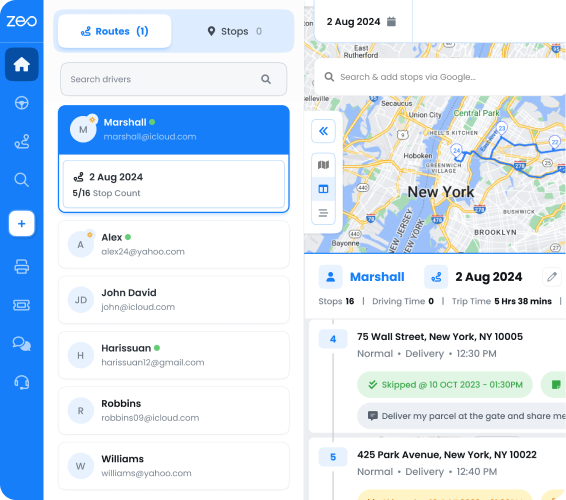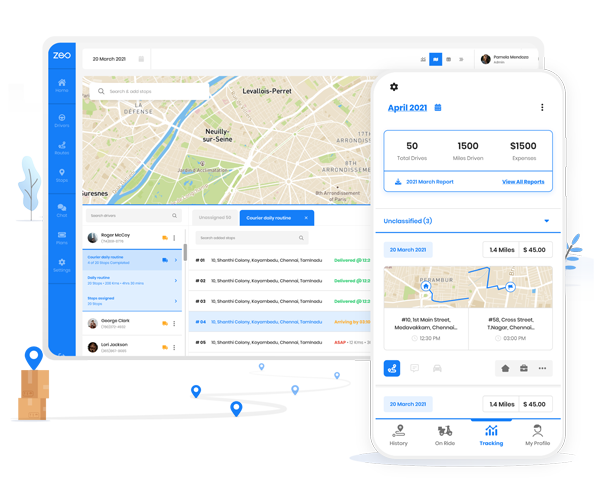Drivers play a very vital role in the last-mile delivery process
Drivers play a very vital role in the last-mile delivery process. They are the ones who complete the chain of the delivery process by providing the packages to the customers on time, and thus there comes the need for delivery driver training. Improving your new driver training process benefits your company, your drivers, and your customers.
When drivers become more efficient, they deliver more packages in less time, saving your money while making your customers happy, and the drivers themselves earn a better per hour rate. We spoke to Nimit Ahuja, who runs a drivers training institute and provides staffing to various delivery management companies, to understand how he trains the drivers, especially delivery drivers, and how it can help a delivery business raise its profits.
We visited Nimit’s institute to see how he carries out all the delivery driver training process and how he provides the top class training services in the market. He covers practical training and educating drivers on keeping the right mindset. Let’s see how he is preparing the drivers for the delivery management businesses.
Ensuring excellent customer service
Nimit told us that on the very first day, he organizes a get-together with the new hires and tries to explain to them the importance of the freight that is being delivered. He says that “We are the final mile. The last link to the client’s customers.”
According to Nimit, delivery drivers should build a good relationship with their customers when they are out on the roads. He teaches the new hire, “If there is leaking oil, then don’t pull onto the customer’s driveway. Don’t block their driveways or their neighbor’s driveways.”

He says the most successful delivery drivers are those who treat their route like it’s their own business. That means caring for the packages like you had boxed them yourself and delivering the packages like you are the one the customer will call if they have any complaints.
Nimit adds that when drivers act like there is nothing more than the messenger between a company and that company’s customer, they’re doing themselves, your delivery company, and the customer a great disservice. First and foremost, he coaches the new drivers carefully to instill a sense of responsibility and accountability.
Using the right delivery software
After explaining the need and importance for the customer’s happiness, Nimit tries to train the new hires on using the delivery management software. This differs between businesses because many delivery firms don’t give out handheld devices to the drivers. Instead, they use their smartphones after downloading the company’s delivery management app.
While talking to use, Nimit said that “It doesn’t take long for most new drivers to pick up the technology side of the job, usually the new drivers comfortable with the technology in less than an hour.” Nimit told us that he often goes on the roads and tries to explore different technology options to understand all the latest trends and train the drivers to the best.

During one of these days out in the field, he discovered the internal route optimization tool his drivers were using wasn’t optimizing routes correctly. To solve that problem, he did some research and found Zeo Route Planner.
He says that the Zeo Route Planner provides an excellent user interface, and the route optimization is so quick and efficient that it makes the last mile delivery operations successful. He also adds that Zeo Route Planner incorporates all the new features required in the delivery business, such as Proof of Delivery and route tracking. He was impressed with our importing address features, where you get the option to import the delivery addresses using a spreadsheet, image capture, bar/QR code, and manual typing.
Training the drivers to think professionally
In continuation with our conversation with Nimit, he added that “While mastering delivery tools is an important part of new driver training, getting the driver in a professional courier’s mindset is critical.” He said that he spends most of his time training the new hires to act and think like professional couriers.

Without adopting their role as professional courier drivers, your new drivers will make subtle but significant mistakes. Delivery drivers are making dozens and possibly close to a hundred stops per day. This means a relatively small 2-3 minute error per stop can significantly delay deliveries overall.
Because of these mistakes, delivery drivers aren’t likely to provide the best customer experience. The more stressed and hurried your driver, the less likely they’re going to provide excellent customer service.
Teaching the delivery drivers how to load a vehicle
Nimit, in his training institute, tries to train his drivers on how to reduce the time drainage, and one of the significant mistakes made by the delivery drivers is not loading their vehicles properly for the delivery. Nimit told us that, “If your drivers don’t load their vehicle correctly from the start, it honestly doesn’t matter if they’re driving on an optimized route or not. It doesn’t matter if they’re the fastest out the door. They run into significant delays and quickly get behind schedule.”

When drivers load their vehicles without consulting their optimized route first, they’re increasing the time it takes to complete each stop because they’ll have to rummage through the packages in their truck (or van) to find the right parcel. What drivers need to do is load their vehicles to complement the order of stops on their optimized routes.
Nimit tells the new drivers to take the first 5-10 packages they need to deliver and put them in the passenger seat (again, also organizing them per their place on the route). This allows the driver to focus on other aspects of the job, such as navigating to the address while using their delivery software. Plus, this is a tangible way to show new drivers the value of making sure their packages are arranged in the right order.

increase fuel savings
Save $200 on fuel, Monthly!
Optimize routes with our algorithm, reducing travel time and costs efficiently.
Get Started for Free
Teaching drivers to navigate and completing the stops
After the drivers understand the importance of loading up their vehicles with their optimized routes in mind, Nimit says that he then trains them to navigate and complete their stops. Nimit says that “I have seen plenty of drivers make time-consuming mistakes when navigating their route and completing their stops.”
According to Nimit, the main problem here is that the drivers don’t think of themselves as professional couriers. Thus he trains them to think of themselves as a professional courier, which we have already discussed above.

He quotes an example of a professional courier driver and tells us that, “A professional courier will keep in mind how street addresses work. Usually odd numbers are on one side of the road, and even numbers are on the other, and a professional courier driver will first check on which side of the street he is when he is finding any address.”
Nimit adds that amateur drivers rely soo much on Google Maps, and they don’t even look at the clues given in the real world. He says that “New drivers will see that their phone has told them they’ve arrived, so they’ll park their car, get the package, and then realize they don’t know where they’re going, but a professional courier driver will at least have some idea of which direction they’re going that way they aren’t wandering around on foot, wasting time, looking around from door to door.”

These may seem like common sense tips or relatively minor suggestions, but as Nimit says, most new drivers are used to driving casually, not professionally. It’s less about common sense and more about the habits you’ve developed as a non-professional driver. When new couriers get behind the wheel, they often don’t know how to act like professional drivers, so this is vital to training their mindset. And since delivery drivers deal in quantity, any cost-saving measure your drivers can implement will have significant benefits for your company.
Nimit tries to train the drivers to correctly use the delivery management software and tell them not to rely entirely upon it. He tries to teach the drivers to use those apps to boost their efficiency and take account of all the real-life clues on the roads when out for delivery.
Teaching delivery drivers to keep themselves safe
Some delivery training courses involve classes in safe driving, driver safety, and even defensive driving. This part of delivery training will vary based on your team’s size and what your drivers are delivering; for example, there’s going to be a completely different safety guide for long-haul delivery truck drivers with a CDL license than there is for a courier delivering packages and completing 30-50 stops a day.
Nimit focuses on delivery drivers who are using their cars as delivery vehicles and don’t have much delivery training knowledge; he trains them to stay safe and healthy on the roads. It’s an unfortunate reality that during the busier holiday seasons, when the streets are full of couriers who deliver gifts to your door, delivery drivers are at a greater risk of being ambushed.

Nimit lastly trains his drivers to keep them safe by being aware of the surroundings and tells the drivers to park the vehicles in a well-lit and observable place. He also suggests his drivers lock all the doors when they are idle or away from the vehicle’s delivery package to the customer’s door.
Nimit also tries to train the drivers to be ready for any weather conditions. He tells them to carry a raincoat with them if the weather outside looks rainy and drive safely on the icy roads. He also advises his drivers to follow all the traffic rules and regulations to avoid any mishappenings on the streets.
Conclusion
To conclude we would like to say that a trained driver can increase your overall profits in the delivery business. If your drivers are not adequately trained, they will lose a reasonable amount of time arranging the packages, finding the right addresses, and many more.
Nimit and his team work always try to train the new drivers with all the qualities to become a professional courier driver. Like plenty of other industries, the COVID-19 pandemic made Nimit’s job more challenging. Though he has adapted himself to all the social distancing norms and safety conditions, he is still committed to instilling the same mindsets and level of practical knowledge in everyone who comes to him.
Nimit says that “Even if we’re in difficult circumstances and the pressure on delivery companies is increasing, we can’t afford to cut corners with training and educating our drivers.” And thus, after talking to Nimit, we recommend you to get your drivers trained if you want your last-mile delivery business to grow.
In the end, we would like to thank Nimit Ahuja and his team for sparing time from their busy schedule to talk to us and explain the importance of delivery driver training. We’re proud to have him as a Zeo Route Planner user, and we’re always happy to hear about his experiences in the delivery world.

Are you a fleet owner?
Want to manage your drivers and deliveries easily?
Grow your business effortlessly with Zeo Routes Planner – optimize routes and manage multiple drivers with ease.

increase fuel savings
Save 2 Hours on Deliveries, Everyday!
Optimize routes with our algorithm, reducing travel time and costs efficiently.
Get Started for Free




















